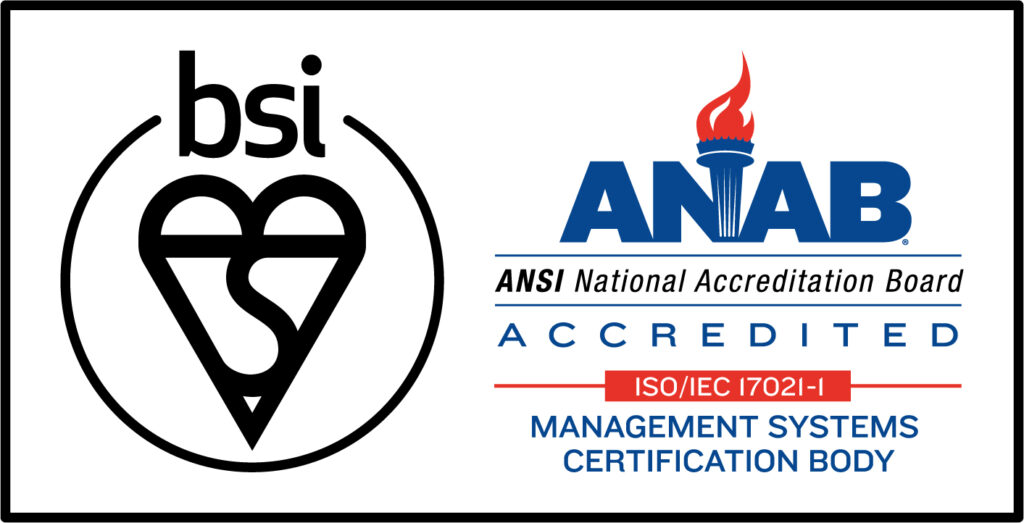Tiếng Anh là một trong những ngôn ngữ phổ biến nhất thế giới. Tuy nhiên, không phải ai cũng có thể nghe hiểu và giao tiếp bằng tiếng Anh dễ dàng.
Tuy nhiên, nhờ sự phát triển của công nghệ và smartphone nên trong quá trình học tập, app dịch tiếng Anh đã trở thành một công cụ hỗ trợ đắc lực giúp người học vượt qua những khó khăn trên.
Trong bài viết này, hãy cùng điểm qua top 10 app dịch tiếng Anh bằng giọng nói chuẩn ngữ pháp và thông dụng nhất qua danh sách dưới đây nhé:
I. App dịch tiếng Anh là gì?
App dịch tiếng Anh là những ứng dụng, phần mềm hỗ trợ chuyển đổi quá trình ngôn ngữ, biên dịch văn bản, tài liệu… từ ngôn ngữ tiếng Anh sang một hoặc nhiều ngôn ngữ khác nhau và ngược lại.
Hiện nay, các phần mềm dịch thuật tương đối đa dạng, bao gồm các phần mềm miễn phí và có trả phí, đáp ứng nhu cầu và mục đích sử dụng của mọi đối tượng người dùng.
App dịch tiếng Anh có 2 loại chính, là
- Phần mềm dịch tiếng Anh văn bản
- Phần mềm dịch tiếng Anh bằng giọng nói
1. App dịch tiếng Anh văn bản
App dịch tiếng Anh văn bản là app sử dụng để dịch nhiều dạng thông tin, từ văn bản, giọng nói, các cuộc hội thoại (hai chiều), hình ảnh và cả chữ viết tay. Những tính năng này hoạt động tương đối tốt trên nhiều ngôn ngữ, trực quan.
2. App dịch tiếng Anh bằng giọng nói
Trước đây, phần lớn các app dịch chỉ có thể dịch từ văn bản sang văn bản, nhưng với sự phát triển của công nghệ nhận dạng giọng nói, các ứng dụng dịch đã có thể dịch giọng nói thành văn bản. Với độ chính xác nhận dạng ngôn ngữ lên đến 97,6% như VoicePing,
Nếu bạn đang là người học tiếng Anh, đang mong muốn có cơ hội được tiếp xúc, làm việc và giao lưu với bạn bè, đối tác, khách hàng mà lại lo sợ trình độ ngôn ngữ của mình chưa tốt thì các app dịch tiếng Anh sẽ là giải pháp cho bạn.
Một app dịch tiếng Anh tốt sẽ giúp bạn dễ dàng:
1. Nói chuyện với người Nhật khi đi du lịch
2. Phá bỏ rào cản ngôn ngữ khi làm việc với người Nhật.
3. Giao tiếp mượt mà với người Nhật làm việc tại Việt Nam
4. Lắng nghe người Nhật phát biểu trong các webinar online lẫn offline.
và còn rất nhiều điều khác nữa.
II. Tiêu chí lựa chọn App dịch tiếng Anh
Để chọn được app dịch tiếng Anh tốt nhất trong số nhiều ứng dụng dịch giọng nói hiện có, bạn sẽ cần trả lời những câu hỏi sau để đưa ra lựa chọn tốt nhất cho bản thân.
1. Chất lượng và tốc độ dịch có tốt không?
Chất lượng dịch là yếu tố quan trọng nhất khi chọn app dịch giọng nói. Chất lượng dịch ở đây bao gồm hệ thống từ ngữ, cách giải nghĩa từ. Ngoài ra, các tính năng như dịch câu, dịch giọng nói, dịch hình ảnh cũng rất quan trọng và tiện lợi.
Chẳng hạn, khi trao đổi với khách hàng, bạn sẽ chẳng thể nào nhắn khách đợi để mình tra từ điển, hay kêu khách hàng nhắc đi nhắc lại cả. chính ở đây, việc 1 ứng dụng có tính năng hỗ trợ dịch giọng nói tiếng Anh lại trở nên vô cùng quan trọng.
2. Mục đích và bối cảnh sử dụng
Lựa chọn ứng dụng dịch tiếng Anh khi đi làm và khi đi học là 2 điều khác nhau. Nếu bạn cần app để sử dụng trong công việc, hãy lựa chọn ứng dụng có khả năng tích hợp với các phần mềm chuyên dụng như Zoom, Microsoft Teams,.. Đồng thời, khi đi làm, để dịch sát nghĩa nhất, bạn cần lựa chọn những ứng dụng có sẵn hệ thống từ ngữ chuyên ngành phù hợp với công việc của bạn, chẳng hạn như đa dạng từ ngữ ngành IT, kinh tế…
Ngược lại, nếu bạn cần ứng dụng để sử dụng trong các tình huống du lịch, bạn nên chọn ứng dụng có giao diện thân thiện với người dùng, tiện lợi và ưu tiên chức năng có thể dịch ngay tại chỗ bằng giọng nói.

3. Miễn phí hay trả phí
Bên cạnh các ứng dụng từ điển tiếng Anh miễn phí như Google Translate, có rất nhiều ứng dụng trả phí hiện nay trên thị trường tuỳ theo nhu cầu và mục đích khác nhau.
Nếu bạn là học sinh sinh viên, chắc hẳn những ứng dụng như Mazii dict là lựa chọn tối ưu nhất. Tuy nhiên, khi đi làm, bạn hoàn toàn có thể tính tới các phương án lựa chọn những ứng dụng dịch tiếng Anh chuyên sâu hơn theo ngành nghề hay yêu cầu công việc.
III. Danh sách 10 app dịch tiếng Anh bằng giọng nói
VoicePing 2.0
Voiceping 2.0 là một app dịch tiếng Anh bằng giọng nói đang rất hot trên thị trường với tính năng dịch giọng nói nổi bật, giúp bạn dễ dàng giao tiếp với người nước ngoài, bất chấp trình độ ngoại ngữ.
Có thể nói, ứng dụng này đáp ứng dường như đầy đủ mọi yếu tố về 1 ứng dụng chuyên môn – chính xác – tốc độ.
“VoicePing” là một công cụ dịch giọng nói chuyên dụng trong công việc, phù hợp với đối tượng người phải giao tiếp và trao đổi thông tin với khách hàng hay cần phải dịch những nội dung khó, đòi hỏi kiến thức chuyên sâu.
Hiện VoicePing đã có hơn 2.000 người sử dụng và được tin dùng bởi các công ty Nhật Bản như Kobayashi Pharmaceutical Co., Ltd. và Denso Corporation.
Với ứng dụng VoicePing, bạn có thể sử dụng Zoom hoặc Microsoft Teams để dịch và ghi chép văn bản theo trực tiếp. Nhờ chức năng dịch ngay lập tức hơn 45 ngôn ngữ, bạn có thể tiến hành các cuộc họp và đàm phán trong kinh doanh mà không lo lắng về rào cản ngôn ngữ.
Nội dung cuộc trò chuyện sẽ được hiển thị như phụ đề trong phim nên rất dễ để theo dõi. Không chỉ giúp việc đàm phán kinh doanh và các cuộc họp diễn ra suôn sẻ, chức năng ghi chép và lưu trữ bản dịch còn giúp bạn tiết kiệm thời gian, công sức và cải thiện hiệu suất công việc.
Bạn cũng có thể tải xuống ứng dụng về điện thoại thông minh để sử dụng như một ứng dụng dịch giọng nói.
Hơn nữa, công cụ này có thể kết nối với màn hình và sử dụng như một công cụ phiên dịch cho các cuộc triển lãm và hội thảo.
Nhiều doanh nghiệp sử dụng công cụ này vì nó được trang bị các chức năng tiện lợi như dịch giọng nói theo thời gian thực và có thể sử dụng an tâm về mặt bảo mật.
App dịch giọng nói VoicePing có các tính năng sau:
- Dịch giọng nói ngay lập tức và chuyển thành văn bản
- Dịch trực tiếp video trên YouTube.
- Sử dụng app như một người biên phiên dịch trực tiếp
- Bạn có thể tóm tắt dữ liệu bản ghi bằng ChatGPT
- Được trang bị ứng dụng để tích hợp với các cuộc họp trên website
- Hỗ trợ 42 ngôn ngữ bao gồm tiếng Anh, tiếng Anh, tiếng Trung, tiếng Việt và tiếng Indonesia
- Voiceping cũng có thể được sử dụng như một công cụ phiên dịch cho các cuộc triển lãm và hội thảo. Một mã QR có thể được sử dụng cho các sự kiện có hơn 1000 người.
Link tải:
Đánh giá: 4.5/5
Webex Meetings
Webex Meeting là một app dịch được sử dụng rộng rãi như một công cụ hỗ trợ các online webinar trên toàn thế giới. Webex Meeting được trang bị chức năng dịch trực tiếp nhưng bạn sẽ phải trả phí. App dịch tiếng Anh này cũng có thể được sử dụng trên website
Các tính năng của Webex Meetings:
- Dịch từ 13 ngôn ngữ sang 108 ngôn ngữ bao gồm cả tiếng Anh
- Dễ nghe với chức năng giảm tiếng ồn
- Tự động dịch nội dung cuộc họp
- Có thể dịch đồng thời 5 ngôn ngữ
- Bạn có thể tự do thay đổi vị trí hiển thị phụ đề, kích thước font chữ, v.v.
Link tải:
Đánh giá: 3.5/5
Google Dịch
Google Dịch là một trong những app dịch tiếng Anh chuẩn ngữ pháp được nhiều người sử dụng nhất. Điểm nổi bật của Google Dịch là khả năng hỗ trợ rất nhiều ngôn ngữ khác nhau trên thế giới. Ngoài các tính năng chính như dịch văn bản và giọng nói thì Google dịch còn giúp người dùng dịch cả website
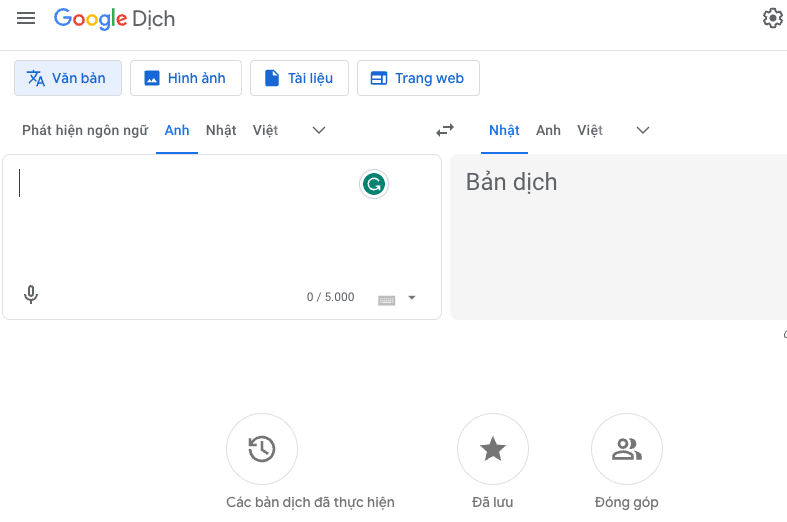
Tuy nhiên, điểm yếu của Google Dịch nằm ở việc tiếp nhận giọng nói. Điều này sẽ vô cùng ảnh hưởng đến chất lượng bản dịch, cũng như công việc của bạn. Dẫu vậy, đây vẫn là một ứng dụng được nhiều người yêu thích và tin tưởng.
Các tính năng nổi bật:
- Hỗ trợ 133 ngôn ngữ
- Hỗ trợ dịch ảnh và văn bản
- Dịch văn bản ngay cả khi không kết nối mạng
Link tải:
Đánh giá: 3/5
Microsoft Translate
Microsoft Translator là một app dịch tiếng Anh do Microsoft phát triển. Ứng dụng dịch thuật này hỗ trợ dịch văn bản, dịch giọng nói, dịch hình ảnh và dịch website bằng hơn 100 ngôn ngữ khác nhau. Phần mềm dịch tiếng Anh Bản Microsoft Translator có thể được sử dụng trên nhiều nền tảng, bao gồm web, máy tính, điện thoại máy tính bảng.
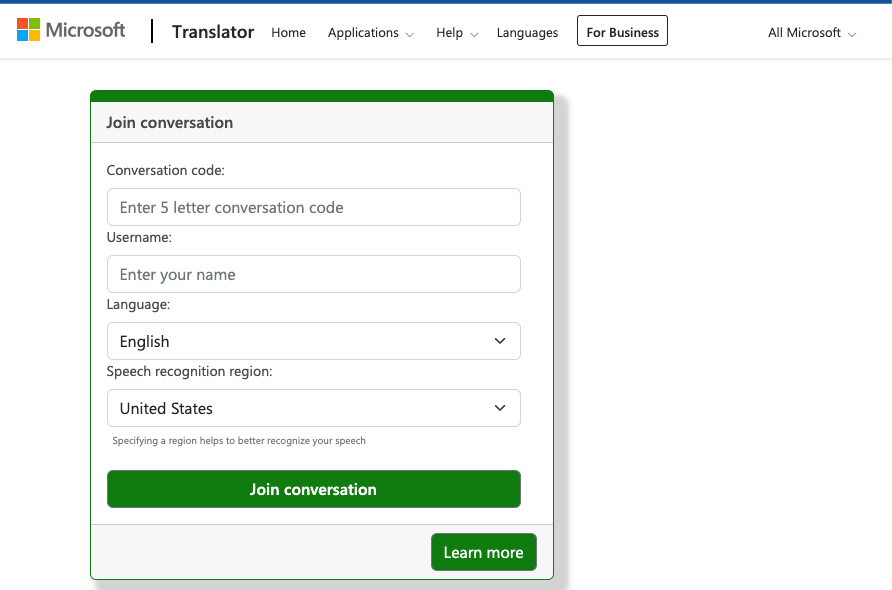
Các tính năng nổi bật:
- Hỗ trợ dịch hơn 70 ngôn ngữ
- Hỗ trợ cả dịch hình ảnh và văn bản
- Dịch văn bản ngay cả khi không kết nối mạng
Link tải:
Đánh giá: 4/5
Papago
Naver Papago là một app dịch tiếng Anh chuẩn ngữ pháp do tập đoàn Naver Hàn Quốc phát triển.
Papago sử dụng trí tuệ nhân tạo để cung cấp những bản dịch nhanh chóng, thuận tiện và chính xác. Đây là một trong những phần mềm dịch tiếng Anh Bản có thể dịch các loại văn bản khác nhau, từ tài liệu chuyên ngành cho đến văn bản thông thường. Đồng thời có thể dịch bằng giọng nói, hình ảnh, hoặc viết tay. Phần mềm dịch tiếng Anh Bản này còn có chế độ dịch offline, không cần kết nối internet.
Tuy nhiên, Papago hiện tại chỉ dịch thuật được 13 ngôn ngữ khác nhau, ít hơn nhiều so với các phần mềm khác.
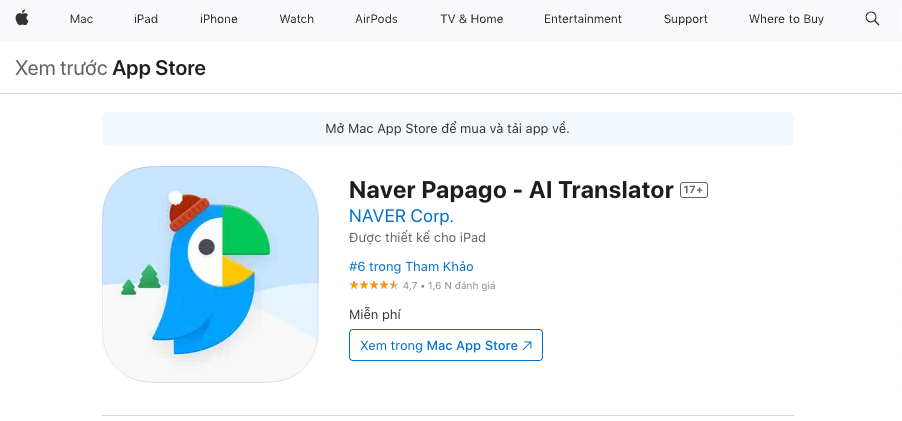
Đặc điểm
– Hỗ trợ dịch ảnh, âm thanh và văn bản
– Hỗ trợ dịch hơn 13 ngôn ngữ
– Dịch văn bản ngay cả khi không kết nối internet
Link tải:
Đánh giá: 3/5
Voice Tra
VoiceTra là một ứng dụng dịch giọng nói miễn phí có thể sử dụng trên điện thoại thông minh và cũng có thể sử dụng trên iPad. Nếu bạn nói chuyện với ứng dụng, nó sẽ dịch nó cho bạn, cho phép bạn trò chuyện với người khác ở các quốc gia khác.
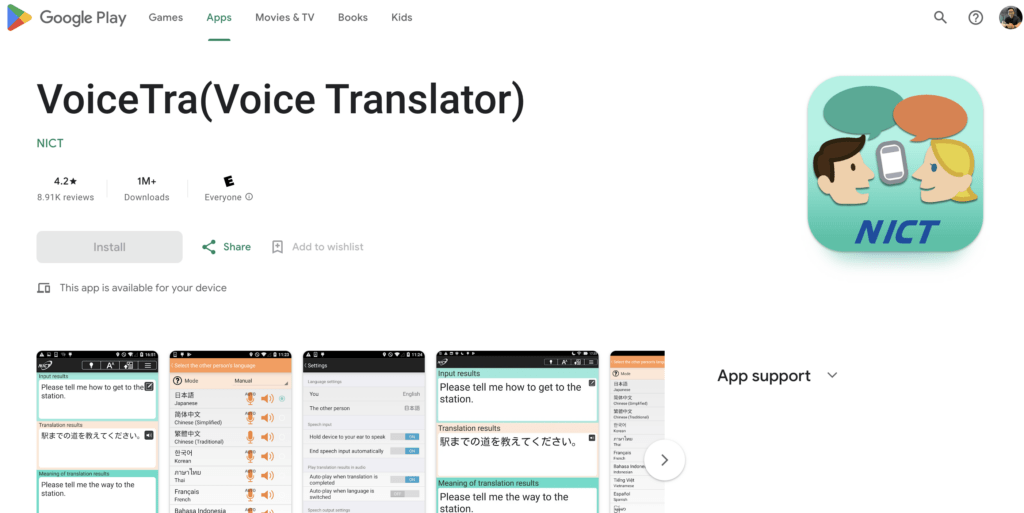
Tính năng nổi bật:
- Hỗ trợ dịch giọng nói
- Hỗ trợ dịch 31 ngôn ngữ
- Bạn có thể chuyển đổi ngôn ngữ dịch ngay khi đang dịch
- Hỗ trợ dịch văn bản
Đánh giá 3.5/5
Link tải:
App Store
Google Play
SayHi Translation
Đây là một ứng dụng dịch giọng miễn phí có thể sử dụng trên điện thoại iPhone và Android. SayHi cũng tương thích với iPad. Bạn có thể sử dụng app dịch tiếng Anh này miễn phí.
Tính năng nổi bật:
- Hỗ trợ 54 ngôn ngữ
- Tương thích với các giọng địa phương của ngôn ngữ nước ngoài
- Dễ sử dụng với giao diện đơn giản

Đánh giá 2.5/5
Link tải: Website
Talking translator
Đây là một ứng dụng dịch giọng miễn phí có thể sử dụng trên điện thoại thông minh Android. Không khả dụng trên điện thoại iPhone và iPad. Dịch giọng và văn bản trong thời gian thực là khả thi.
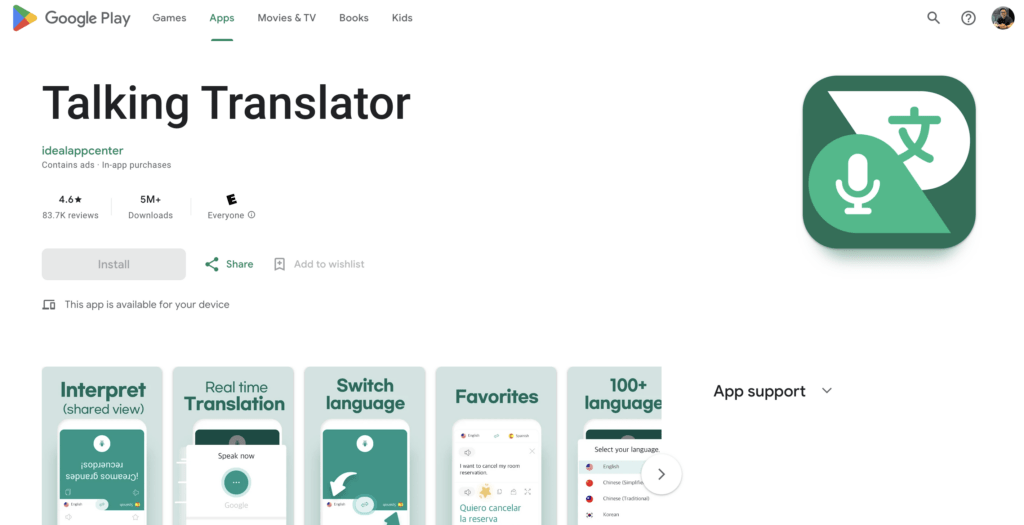
Tính năng nổi bật:
- Hỗ trợ cả dịch văn bản
- Hỗ trợ hơn 100 ngôn ngữ
- Chứa đựng các cuộc trò chuyện hàng ngày được sử dụng thường xuyên
Đánh giá: 1.5/5
Link tải: Google Play
UDictionary translator
Đây là một ứng dụng dịch giọng miễn phí có thể sử dụng trên điện thoại thông minh iPhone và Android. Cũng tương thích với iPad.

Tính năng nổi bật:
- Hỗ trợ dịch 108 ngôn ngữ
- Hỗ trợ cả dịch hình ảnh và văn bản
- Có thể dịch không cần kết nối internet
- Kèm theo từ điển của 44 ngôn ngữ
Đánh giá: 2.5/5
Link tải:
V-Cube
V-Cube là một app họp trực tuyến trên web với chất lượng âm thanh và hình ảnh cao cấp. V-Cube được tích hợp với Office 365 của Microsoft. V-Cube cũng có thể dịch trực tiếp giọng nói trong cuộc họp

Các tính năng nổi bật:
- Tự động dịch nội dung cuộc họp
- Bạn có thể làm khảo sát trong suốt cuộc họp.
- Hỗ trợ hiển thị văn bản dịch với 52 ngôn ngữ bao gồm tiếng Anh, tiếng Anh và tiếng Trung
- Dễ sử dụng với giao diện đơn giản
- Giá cả và dịch vụ sẽ được xử lý cá nhân từng trường.
Đánh giá: 1.5/5
Link tải:
IV. Đánh giá ứng dụng phù hợp nhất cho bạn
Nếu bạn đang tìm kiếm một app dịch tiếng Anh hoàn hảo để có thể làm việc trơn tru với các đối tác, đồng nghiệp đến từ Nhật Bản thì VoicePing 2.0 sẽ là sự lựa chọn hoàn hảo cho bạn.
Trong công việc, có rất nhiều tình huống đòi hỏi bạn phải trả lời nhanh chóng để có thể đảm bảo công việc được diễn thật tốt. Sẽ thật không hay nếu như bạn không thể nghe rõ được những gì sếp nói đúng không? Những lúc như vậy, hãy để VoicePing hỗ trợ bạn nhé.
Hiện nay, VoicePing là app dịch tiếng Anh duy nhất không chỉ dịch giọng nói giúp bạn mọi lúc mọi nơi, mà còn có thể tích hợp với các phần mềm như Zoom hay Microsoft Teams. Ngoài ra, với sự phát triển của A.I. (trí tuệ nhân tạo) được tích hợp trong VoicePing, bạn sẽ không phải lo nghĩ quá nhiều về độ chính xác của bản dịch.
Tải VoicePing ngay tại:
Tổng kết
Tuỳ vào những nhu cầu và hoàn cảnh khác nhau mà bạn có thể lựa chọn những ứng dụng dịch tiếng Anh phù hợp cho riêng mình. Nếu bạn đang tìm kiếm một ứng dụng phục vụ mục đích học tập hay dịch những văn bản thông thường, Google Translate có thể đã là một ứng dụng “ngon – bổ – rẻ”. Tuy nhiên, nếu lựa chọn cho mục đích làm việc, các công việc có chuyên môn cao hơn hay đòi hỏi giao tiếp với người nước ngoài, ắt hẳn những ứng dụng như Voiceping sẽ là lựa chọn tốt nhất


